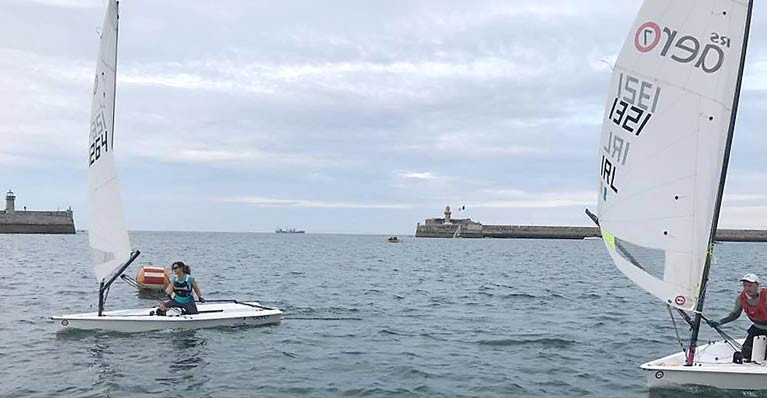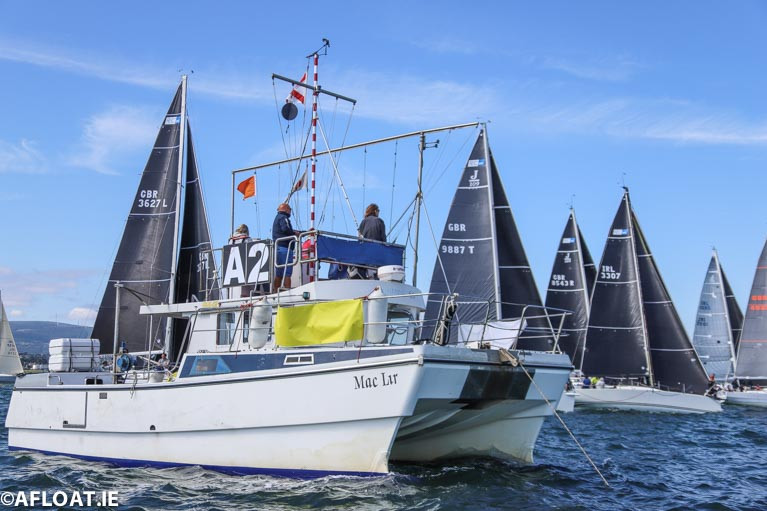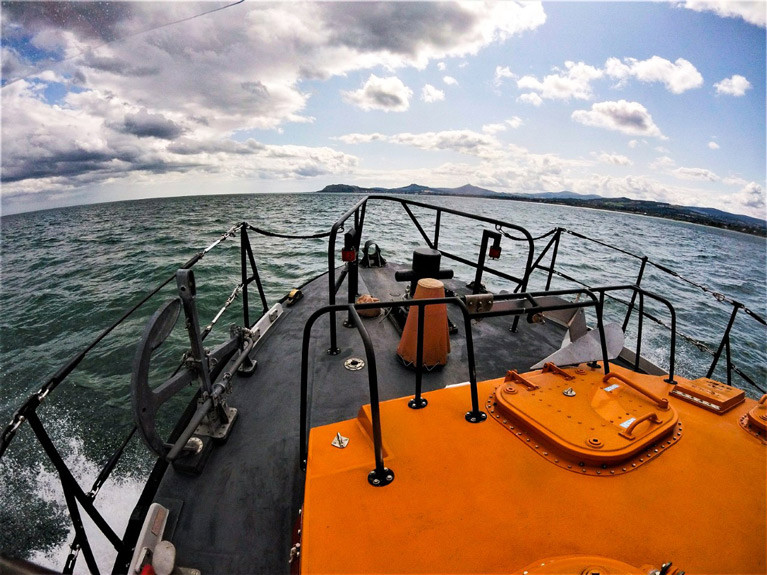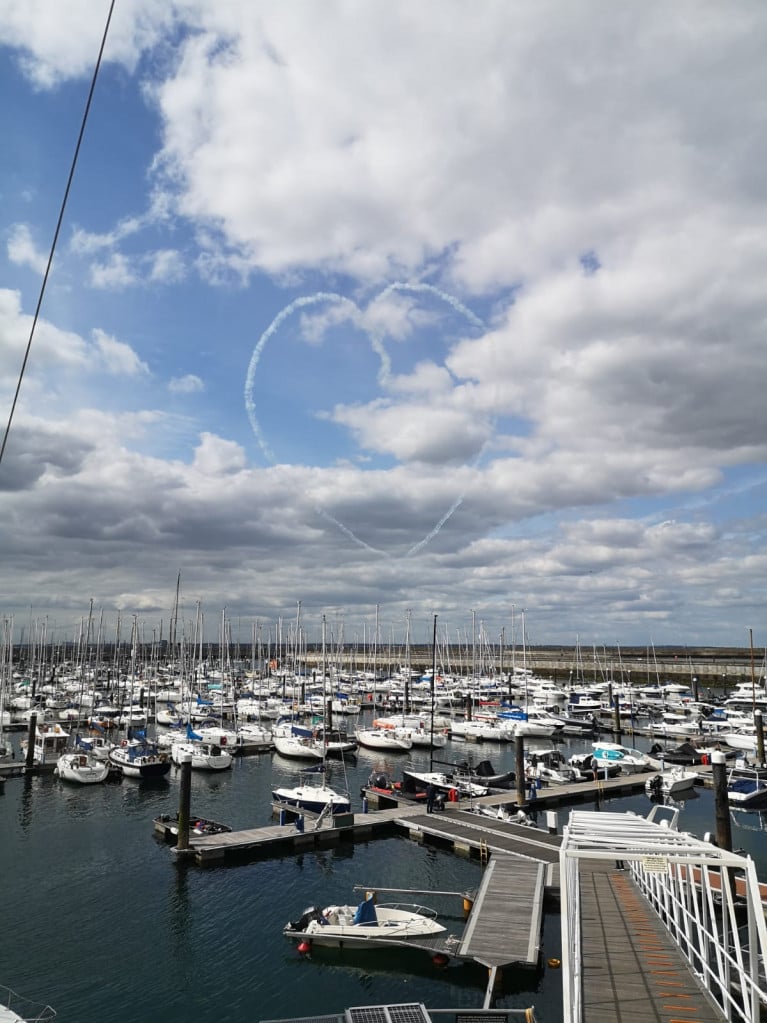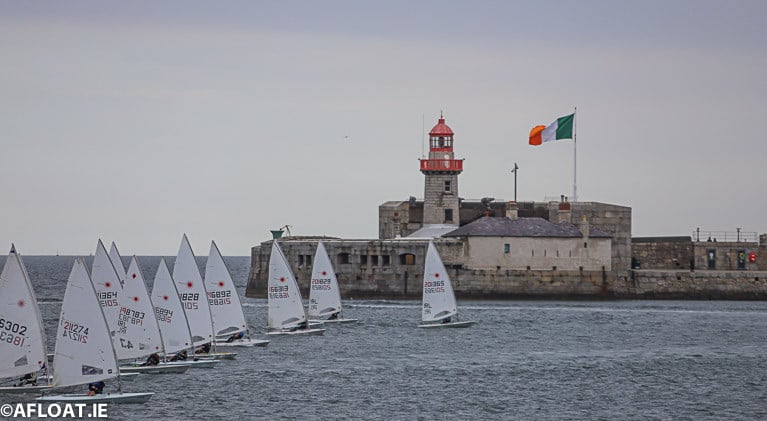Displaying items by tag: Dun Laoghaire Harbour
Dun Laoghaire Harbour RS Aero Set the Pace in DBSC PY Fleet
The new RS Aero fleet now comprises the biggest one-design class, racing in the DBSC PY fleet. From zero boats last year in DBSC, there are now six Aeros racing competitively and there are rumours of more boats on the way. Not only are the boats great in one design but also have demonstrated great handicap ability under the PY system with five of the Aeros holding the top 5 places overall in the Tuesday Series with Noel Butler in the lead and Brendan Foley’s Aero leading overall in the Saturday Series.
Last night saw Noel Butler win both windward/leeward races showing excellent upwind speed and good race management to avoid the bunching on the short harbour based course. The rest of the boats traded places in the shifty winds with lightweight flyer ‘Skinny’ Sarah Dwyer and athletic Stephen Oram showing excellent speed, almost match racing each other around the track.
 RS Aero DBSC racing at Dun Laoghaire Harbour Photo: Afloat
RS Aero DBSC racing at Dun Laoghaire Harbour Photo: Afloat
What is amazing is the variety of sailing styles witnessed as the fleet learn to sail the boats quicker. The high/low modes upwind can have huge gains or losses and being only 30 kilos heavy the boats really respond well to the small gusts with excellent acceleration. Downwind the boats run more by-the-lee than the Finns and the Lasers with some sailors choosing the big windward heel and others going flat to keep the chines out of the water.
The training clinics of Maurice ‘Prof’ O’Connell over the last few months have helped the fleet to come on with his knowledge and drills supporting the rise in the standard.
One of the features of the Aero class is sharing knowledge and the Dun Laoghaire Harbour fleet is no different with race winners sharing what worked and didn’t - the net effect has been a great rise in overall standard with any of the 6 boats capable of a top 3 placing.
This augers well for the RS Aero Irish Open Championship being held on the 19th and 20th of September 2020 at the INSC in Dun Laoghaire.
If you would like to sail an Aero and try it out ask any of the sailors with boats in the NYC or RStGYC. The class plan to have some open days for a try-out within COVID guidelines in the next few months.
Dun Laoghaire Harbour Clubs Schedule Joint September Regatta to Celebrate National Yacht Club's 150th
At the start of COVID 19 pandemic, the sailing community in Dun Laoghaire began planning for one event to replace the four individual waterfront yacht club regattas.
The original regatta plan had two potential dates July 31st/ August 1st - or Sept. 5/6th. The event is an initiative of all five of Dun Laoghaire's yacht clubs as a response to the COVID-19 interrupted season.
In the light of recent delay to Phase 4 of reopening, the later date is being chosen and an event is being designed to meet the COVID-19 protocols.
The event will be hosted by the National Yacht Club who are celebrating their 150th year.
It is being supported by the other Clubs – RIYC, RSGYC and DMYC, whose members will take part.
In what is turning out to be a bumper September for Irish sailing, the event will run a fortnight after the Round Ireland Race from Wicklow (August 22nd) and a week before the ICRA National Championships at Howth as part of the North Dublin Club's WAVE regatta on 11/13 September.
 National Yacht Club Commodore Martin McCarthy
National Yacht Club Commodore Martin McCarthy
The event will also have a trophy to mark 100 years since the renaming of the town to Dun Laoghaire and will be supported by Davy Group who will provide prizes and support.
National YC Commodore, Martin McCarthy commented: “We are thrilled that the other clubs have so generously given us the opportunity to celebrate our 150th with a Regatta, in a year where sailing time has been very condensed. The event is being designed to meet the requirements of the battle against COVID 19, so Apres Sail will be restricted.

"We will have 10 Commemorative medals struck for race winners across the waterfront and a singular trophy to mark 100 years of Dun Laoghaire for the finest Classic boat taking part".
"We especially thank Davy Group whose loyalty and ongoing sponsorship during this pandemic has contributed greatly to running this event.
It will be an important step on the road to “new normal” and which we hope will finish with a rowing race in Dublin Bay".
At 10:21 am today (Saturday 18 July), Dublin Coast Guard requested Dun Laoghaire Harbour RNLI to assist three people on board a 35ft yacht which had its propeller fouled approximately two miles of the Dublin coast.
The all-weather lifeboat was launched under Coxswain Mark McGibney with six crew onboard and made its way to the scene arriving at 10:55 am. The all-weather lifeboat took the vessel in tow and brought it to Dun Laoghaire Harbour arriving at 12:00 pm.
Weather conditions at the time were described as good with a slight wind and good visibility.
Speaking following the call out, Mark McGibney, Dun Laoghaire RNLI lifeboat Coxswain said: ‘This can happen to anyone but it’s great to see the people involved wearing lifejackets and have the correct means of communication to call the Irish Coast Guard for help, which was the case today. I’d like to take this opportunity to ask everyone to make sure that their vessel engines and safety equipment are checked and in working order before taking to the water.’
Dun Laoghaire RNLI Take Motorboat Under Tow
It was the second shout for leisure boats this week for the Dun Laoghaire lifeboat crew. On Wednesday the all-weather lifeboat was called to assist a 35-motorboat off the County Wicklow coast at Bray as pictured below
 Dun Laoghaire RNLI tow a motorboat back to the harbour Photo: Afloat
Dun Laoghaire RNLI tow a motorboat back to the harbour Photo: Afloat
Olympians Finn Lynch & Annalise Murphy Win First Race of Dublln Bay Water Wags 2020 season
We think of the venerable Dublin Bay Water Wags as being the quintessential Dun Laoghaire Harbour class. But when the results of their first race of the delayed 2020 season yesterday (Wednesday) evening were analysed, it was noted that the top performers in the turnout of 13 gleaming varnished classic boats included many from outside the leafy confines of South Dublin.
Former Olympian and current classic boat pace-setter Cathy MacAleavey was unable to race owing to having had a hip replaced on Monday (we wish her well), but she made sure her boat, No 42 Molly, was in with a chance through being raced by Olympians Finn Lynch (originally of Blessington SC) and her daughter Annalise Murphy (NYC), Silver Medallist in the 2016 Rio Olympics.
 Sailing is really going again when the Water Wags make their first appearance – William Prentice’s Tortoise (42), Adan Winkelmann (46) and the O’Driscolls from Lough Derg (15) in perfect first race sailing conditions
Sailing is really going again when the Water Wags make their first appearance – William Prentice’s Tortoise (42), Adan Winkelmann (46) and the O’Driscolls from Lough Derg (15) in perfect first race sailing conditions
 The 1915-built Barbara (Ian & Judith Malcolm), crossed the in-harbour line to take fourth
The 1915-built Barbara (Ian & Judith Malcolm), crossed the in-harbour line to take fourth
The hotshots duly obliged by winning, but the top placings thereafter indicated that interest in Water Wag racing is at the very least a Leinster-wide matter, for although Guy KIlroy of Dun Laoghaire was second with Swift, he’s no stranger to the more remote hidden waters of the North Shannon, while third was also Shannon-oriented, as the O’Driscoll family of Lough Derg YC – noted Shannon One Design sailors – have added a Water Wag to their boat portfolio. To make the spread complete, fourth place was snatched by “the Howth boat”, the 1915-built Barbara campaigned by Ian and Judith Malcolm, who are best known for their links to the Howth 17 class and other classics from the board of their local designer Herbert Boyd.
 The classic Water Wag image to launch the 2020 season - Adrian Masterson brings his boat to the mark.
The classic Water Wag image to launch the 2020 season - Adrian Masterson brings his boat to the mark.
More Time To Fly Your Flag At Dun Laoghaire Harbour
Dun Laoghaire’s local authority has extended the deadline to take part in its summer flag-making initiative.
As previously reported on Afloat.ie, locals of all ages are invited tell their own Covid-19 story with a flag of their own making.
Submitted flags will then be flown from the masts of boats among Dun Laoghaire’s sailing community which will display them in a flotilla on Dublin Bay.
Hundreds of flags have already been received by Dun Laoghaire-Rathdown County Council, but the authority said there are lots more stories to tell so they have pushed the deadline back to the end of summer.
For more details on how to take part and create your own flag, click HERE.
A new cycle lane at Dun Laoghaire Harbour runs across the primary access route for the town's RNLI Lifeboats, one of the busiest stations in the country and restricts the lifesaving service in its emergency response, according to the Dun Laoghaire RNLI.
The new scheme, currently under construction, also blocks the direct route to the National Yacht Club (NYC) at the town's East Pier.
Mr Stephen Wynne, the Lifeboat Operations Manager at RNLI Dun Laoghaire told Afloat the lifesaving charity was currently 'in consultation with DLRCoCo to find an amicable solution'.
The traffic management plan includes road closures as part of an overall plan to implement a cycle lane through the town to the popular Forty Foot bathing place in nearby Sandycove.
 An artist's impression of the new 'DLR Coastal Mobility intervention' at Queens Road as envisioned by DLRCoCo
An artist's impression of the new 'DLR Coastal Mobility intervention' at Queens Road as envisioned by DLRCoCo
Access from Queen's Road 'is the primary access route used by volunteer lifeboat crew in the provision of its 24/7 lifesaving service and it is restricted as a result' Mr Wynne says.
Access to the NYC and the lifeboat station is now via the harbour roundabout at the nearby Royal St. George Yacht Club but already, at certain times of the day, new road markings at the roundabout are restricting traffic flow, according to harbour users.
DLRCoCo has also relocated its weekend markets from the Peoples Park to Queens Road between Park Road and the entrance to the Pavilion car park resulting in the road closure to all but pedestrians and cyclists.
 New road markings at Dun Laoghaire Harbour roundabout Photo: Afloat
New road markings at Dun Laoghaire Harbour roundabout Photo: Afloat
As a result, it means RNLI crews responding to an emergency call-out and travelling by car are effectively blocked coming from the east and potentially severely restricted arriving from the west depending on the time of day.
A spokesman for the NYC said the club – the Irish yacht club of the year in 2018 – had 'no comment' to make in relation to the scheme.
The cycling schemes form part of the County-wide plan of temporary measures to address the challenges in the public realm resulting from Covid-19 related to public health and safety, mobility and to support the recovery of the local economy. The Council says on its website there have been high increases in cycling numbers on routes along the coastline in May 2020, according to real-time data from cycle counters. When compared with May 2019, cycling numbers in Blackrock Park almost doubled, rising from over 16,385 cyclists to 29,666 cyclists over the month of May.
A request for comment from DLRCoCo was not responded to by the time of publication.
UPDATE: July 17. DLRCoCo response as follows:
In response to Covid-19, Dún Laoghaire-Rathdown County Council (DLRCC) has made safety-critical changes to the layout of the roads infrastructure on roads on the coastal route between Blackrock and Sandycove to reallocate road space so as to protect the health and safety of the significantly increased numbers of cyclists and pedestrians who are accessing the coastal route.
There has been an almost 100% increase in the number of cyclists using the coastal route. According to real-time data from cycle counters in Blackrock Park in May 2020 there were 29,666 cyclists compared with 16,385 cyclists in May 2019. A very distinct pattern has emerged during the Covid-19 restrictions with a wide variety of ages and abilities observed to be cycling on the road.
DLRCC as a local authority and a road authority has a duty of care to all road users, particularly vulnerable road users such as cyclists and pedestrians, and the mobility interventions, including the provision of a 2-way segregated cycle way, have necessitated changes to the road layout along Queen’s Road and in the Harbour area. In order to avoid a conflict between cyclists on the 2-way cycle way and vehicles, it was deemed necessary from a safety perspective to prevent access to vehicles via the access point in the Harbour closest to the East Pier. However, there are still clear vehicle access routes through to the RNLI lifeboat station in the Harbour via the Marine Road/Crofton Road junction and at York Road/Crofton Road junction, via the Cold Quay Bridge.
DLRCC has met on a number of occasions with RNLI representatives about the plans for the mobility interventions on Queen’s Road and in the Harbour area and plans further engagement so as to ensure that DLRCC as a road authority and RNLI as a lifesaving charity can meet their respective safety-critical responsibilities.
The dlr CoCo Markets was located on a trial basis on Queens Road on 12th July but this will not continue and the Market will be relocated to nearby locations which means that Queens Road will be open to vehicular traffic under the new one-way system during the week and at weekends.
Graffiti continues to be a problem for Dun Laoghaire's heritage harbour with extensive ugly, anti-social daubs on the walls of the pier and its disused buildings on the West Pier Head.
Expert advice on an economic plan for the harbour on Dublin Bay is being sought by Dun Laoghaire Rathdown County Council on a future direction for the harbour that is a national monument.
As Afloat reported last month, the Victorian Harbour has not escaped the vandalism of graffiti 'artists' this summer. Unoccupied cut-stone buildings on the town's West Pier were blighted by the spray can in June and although it was promptly removed, the seaward side of the building has now also been defaced.
The council says graffiti poses a significant problem throughout the Dun Laoghaire area. To report graffiti, contact 01 2054817 or email [email protected]
A 'Red Bull' tribute to Front Line COVID-19 pandemic staff took place over Dublin Bay this afternoon leaving massive heart shapes in the sky over Dun Laoghaire Harbour.
The Red Bull Flyover Project was originally planned for the Bay at 1 pm but instead took place three hours later at 4 pm in fine but cloudy weather.
Two Red Bull formation aircraft operated offshore, east of Poolbeg chimneys and south towards Dun Laoghaire Harbour, generating approx ten hearts.
Two safety RIBs were positioned offshore as well as a Dublin Port Pilot boat to provide support for the stunt.
 Heartfelt: Red Bull stunt planes make shapes in the sky over Dublin as a tribute to COVID-19 front line staff
Heartfelt: Red Bull stunt planes make shapes in the sky over Dublin as a tribute to COVID-19 front line staff
Laser DBSC Dinghy Racing Resumes with Big Fleet at Dun Laoghaire Harbour (Results HERE!)
Tuesday evening Dublin Bay Sailing Club (DBSC) dinghy racing got off to a great start in Dun Laoghaire Harbour tonight with a bumper Laser fleet competing.
As Laser Class Captain Gavan Murphy predicted on Afloat a fortnight ago, there was a super turn out of single-handers for the first race of the COVID delayed season.
The 50-boat Laser fleet enjoyed ten-knot southerly winds for the in harbour racing run from DBSC's Freebird Committee Boat.
Also racing were RS Aeros, Fireballs and PY dinghies.
 Part of the 65-strong DBSC Laser fleet
Part of the 65-strong DBSC Laser fleet
DBSC Results for 30/06/2020
All results Provisional & Subject to Review
Race 1
PY Class: 1. B Sweeney, 2. N Butler, 3. B Foley
Fireball: 1. F Miller, 2. 14865, 3. N Miller
Laser Standard: 1. R Wallace, 2. D Maloney, 3. R O'Leary
Laser Radial: 1. M Norman, 2. R Geraghty-McDonnell, 3. K O'Connor
Laser 4.7: 1. A Daly, 2. C Byrne, 3. H Turvey
Race 2
PY Class: 1. B Sweeney, 2. N Butler, 3. B Foley
Fireball: 1. F Miller, 2. C Power/M Barry, 3. 14865
Laser Standard: 1. R Wallace, 2. R O'Leary, 3. G O'Hare
Laser Radial: 1. P O'Reilly, 2. K O'Connor, 3. R Geraghty-McDonnell
Laser 4.7: 1. A Daly, 2. E Dempsey, 3. Z Hall
Dun Laoghaire Harbour RNLI rescued an angler who had slipped and fallen into the water at Dun Laoghaire’s West Pier today (Tuesday 30 June)
The volunteer lifeboat crew were paged following a report made to the Irish Coast Guard that an angler was in difficulty after falling into the water. The man was with a group who alerted them of the incident.
The inshore lifeboat was launched immediately at 13:44 pm and made its way to the scene arriving at 13:49 pm, just minutes after launching. Dun Laoghaire Coast Guard shore unit also attended the scene.
Weather conditions at the time were described as good with a calm sea, light wind, and good visibility.
On arrival, the lifeboat crew assessed the situation and quickly transferred the man on board the lifeboat. They carried out a casualty care assessment and with the casualty deemed in good health, they returned to Dun Laoghaire Harbour where the casualty was placed into the care of an awaiting HSE ambulance crew for a secondary medical assessment.
Speaking following the call out, Mark McGibney, Dun Laoghaire RNLI Lifeboat Coxswain said: ‘ The outcome of this incident was a positive one and the group of anglers who were with the man when the incident happened did the right thing by calling the Irish Coast Guard and asking for help. It is important that shore anglers remember that should they get into difficulty or see someone getting into difficulty to dial 999 or 112 and ask for the Irish Coast Guard.’


























